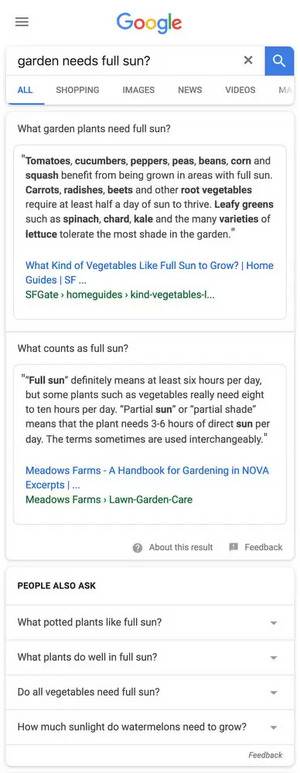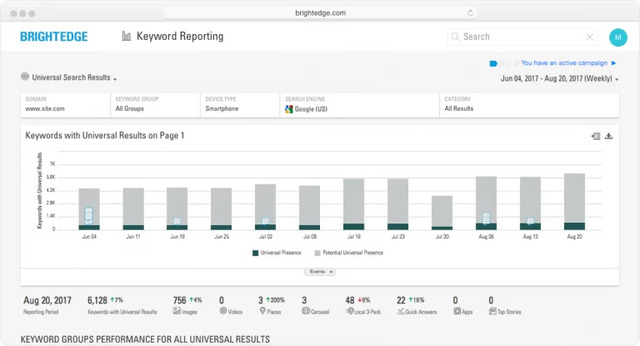Google has begun displaying multiple Quick Answers on certain search engine result pages (SERP). How does this impact optimizing for the Quick Answer box and featured snippet placements?
Buried in a January article on Google's The Keyword webmaster blog was a mention that the search engine giant was going to start displaying more than one Quick Answer featured snippet on a single SERP. The article stated:
"Another format coming soon is designed to help people better locate information by showing more than one featured snippet that’s related to what they originally searched for... Showing more than one featured snippet may also eventually help in cases where you can get contradictory information when asking about the same thing but in different ways."
By displaying more than one Quick Answer on certain SERPs, Google hopes to expose searchers to a wider array of information sources, especially in cases where an authoritative answer to the query is under contention. Of course, for SEOs and digital practitioners this change presents a lot of questions: Does this affect the process for going after placement? Will it lower the click-through rate for sites that hold the Quick Answer spot on a key SERP?
SEO benefits of having the Quick Answer
It might be hard to remember now, but there was a brief time when some SEOs viewed the featured snippets, and the Quick Answer box in particular, with mixed feelings. Early on there were worries that being in the Quick Answer position, especially for query-based keyword phrases, would actually lower the CTR to a brand's site from that SERP. After all, if the user's query is answered right there on Google's page, why bother clicking through to the site that Google is citing in its featured snippet? A 2015 case study by SearchEngineLand columnist Glenn Gabe noted a loss of more than 39,000 clicks for a site that lost the featured snippet placement for a competitive keyword. The following year HubSpot published a study that was even more conclusive: In looking at SERPs for high-volume keywords it found that sites in the featured snippet position enjoyed a CTR increase of over 114%, even when the same site already ranked #1 in the organic listings. We also know that Quick Answers, along with other featured snippet types, is playing a large role in voice search results, as noted by Danny Sullivan of SearchEngineLand back in 2016:
Google Home will use Featured Snippets for answers. Source credited but not like getting a click #MadeByGoogle https://t.co/ZLMqVwHpvc pic.twitter.com/GkE7n3kovb
— Danny Sullivan (@dannysullivan) October 4, 2016
While not the same kind of direct impact as a click, the source attribution provided by Google Home still provides a marketing touch that connects the searcher with your brand, encouraging them to explore further if your content resonates. Having that position also prevents your competitor from getting the mention and branding. It's clear now that the Quick Answers box is a desirable place to be. But what happens when there's more than one?
Do multiple Quick Answers hurt SEO impact?
Your first inclination might be to think that this will reduce the CTR boost provided by holding the Quick Answers position. If the Quick Answers box, "Position 0" on the SERP, provides X amount of CTR boost then it should follow that introducing a "Position -1" would reduce that boost to X/2, right? (or maybe that's just if you're a pessimist like me). It's still too early to make any definitive statements, but we are not necessarily convinced that a reduction will be the case.
What is Google saying about multiple Quick Answers?
As noted earlier, Google said that it is rolling out multiple Quick Answers on a single SERP as a means of presenting additional data sources and/or points of view, especially for queries where the answer is in contention and contradictory answers exist. In another blog post, Google stated that it intends to start with what it calls "multi-intent queries" where there could be several potential intentions associated with the question being asked. For example, the query below, "garden needs full sun?":  The query isn't in written in full sentence structure, so Google has gone out on a semantic limb to present answers for associated queries "what garden plants need full sun" and "what counts as full sun?" in addition to a People Also Ask box underneath.
The query isn't in written in full sentence structure, so Google has gone out on a semantic limb to present answers for associated queries "what garden plants need full sun" and "what counts as full sun?" in addition to a People Also Ask box underneath.
Why multiple Quick Answers won't likely affect CTR
By its own admission, Google is still in the experimentation stage of having multiple Quick Answers for a single query, so it isn't prudent to make too many predictions until there's been time for more user data to come in.
Google has said, however, that its aim in the near future is to expand the feature from multi-intent queries to also cover "guidance-seeking queries." This would entail multi-faceted queries like "is it worth aggregating smaller SEO tools?"
Theoretically, the Quick Answers section of the SERP would present you with answers covering various facets, such as cost-benefit analysis, IT compliance, onboarding, integration requirements, etc.--all of which pose a variety of new and potentially interesting opportunities for organic search marketers and SEO to get their content in front of the eyes of low-volume, high-intent audiences who are asking highly specific questions about a product or service.
In short, it doesn't seem like multiple Quick Answers will create a global drop in CTR for lower-placed answers because Google's intent is to provide different types of answers, not simply a flat architecture of competing answers.
What it likely will create, however, is a need for additional focus on optimizing the query-answering sections of your ranking content to provide the best possible answer versus competitors within the Quick Answers grid. Ascertaining the customer intent behind keyword phrases that have featured snippets on them will be more important than ever.
Effect on optimizing for Quick Answers box
Because of how Google has rolled out this change to featured snippets, we don't anticipate that the best practices for appearing in Quick Answers will change either. We suggest that for the time being, SEOs and digital practitioners stick to the Quick Answers optimization practices we detailed in a variety of places, including our comprehensive white paper on How to Get Into Quick Answers.
If your site ranks in Quick Answers for keyword phrases that you've identified as valuable to your brand, begin monitoring those results over time to see if multiple Quick Answer boxes begin appearing on the SERPs. You should also continue to monitor two other basic metrics:
- Total number of Quick Answers positions you rank for
- Total number of tracked keywords that have Quick Answers featured snippets, but you don't rank for them
Knowing the Quick Answers you do rank for will help you to narrow down your search for SERPs with multiple Quick Answers. You can create a keyword group to monitor the progress, and make sure you defend those positions. Additionally, knowing the keywords with Quick Answers presence will help you to identify and isolate ones to pursue in the near future. Once you have identified these keywords you can optimize and create content to rank for those Quick Answers. And now with this change in Google, you can run a Data Cube analysis to find all semantically related terms to make sure your content covers all major areas for that one topic. For example, keyword phrases containing more nuanced, multi-faceted queries like "benefits of marketing automation" could now possibly be opened up to many more ranking opportunities as opposed to the simple binary win-lose of having a basic Quick Answer featured snippet on the SERP. You can easily track both of these metrics by using the Universal Search Results view in the Keyword Reporting module of BrightEdge.

The caveat to all of this is that, as most SEOs working within a smart framework know, any amount of hypothesizing isn't nearly as valuable as real data. Observe the SERPs for the keyword phrases you care about, monitor your CTR both globally and on a per-page basis, and adjust tactics dramatically only when the data supports it and/or a Defend/Recover crisis seems imminent. For an in-depth walkthrough of how to optimize for Google Quick Answers, be sure to download our collection of 20+ best practices.

